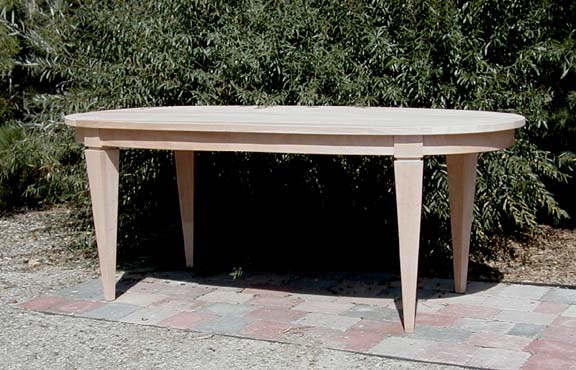Question
I'm building a coffee table with an elliptical apron, uninterrupted by legs, as it will have turned pedestals inset from the ends. I've laminated three pieces of bending plywood around an MDF form, and am very happy with the ellipse. I plan on veneering on a piece of sapele to match the rest of the table which will be solid sapele.
The apron is 3" tall, and about 8' in circumference. The grain of the plywood is vertical, and the veneer will be horizontal. This is my first time building a table, and first time veneering. I have no vacuum press. How can I pull this off? I want the veneer in one solid long piece, ideally. Can I use yellow glue and iron it on? If not, what's the best way of doing this?
Forum Responses
(Veneer Forum)
From contributor D:
I think I'd use the iron on technique. I've done it successfully on oval aprons many times, like the dining table below in African mahogany. Make your veneer wider so you can trim it off later. Glue both the ply apron and your veneer and let it dry before ironing. Your veneer will probably curl like a potato chip, but it will still work. Do a test with some scrap to get a feel for how much glue to use, iron temp, and speed.

The minute yellow glue is applied to the veneer it curls and will be unmanageable in long continuous lengths. With pre-applied glue, how do you keep the glue line even and thin and conform to every whim of the substrate? The iron is a dry heat. How hot is enough to re-melt the glue on both surfaces before there is damage to the veneer? Itís wood and will scorch. This heat adds to the problem by making the veneer brittle, which allows those hidden flaws, Murphy warned us about, and as all woodworkers know abound within our materials, to make their presence known.
The hide glue process is very easy, you can manipulate the viscosity of the glue to fit the situation, and the squeeze out does not settle into the grain like yellow glue, adhering to curves is fast. You can do it by yourself. Thinning of the hot glue line is done with the veneer hammer. I like my shop made hammers over the traditional version. Preparation of the substrate is very important to avoid telegraphing flaws through the veneer, no matter which method is used.
I canít imagine adhering an eight foot long piece of veneer on with a strap clamp, while the open time of the glue is dwindling and insuring an even glue line pressure. I have a hard enough time getting the dust collection bag back on the dust collector with one.
I don't use yellow glue for this application either. I've used both epoxy and polyurethane glues successfully. I've done a ton of these things too, working in a shop that did lots and lots of round tables. Doing it solo is tough I admit, but it is doable. I usually had a second set of hands though.